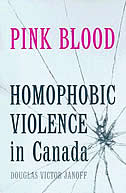Pink Blood


Pink Blood: Homophobic Violence in Canada
By Douglas Victor Janoff
This book looks at homophobic violence in Canada since 1995. A consistent theme throughout is the failure of hate crimes legislation in Canada to capture, address and respond to instances of “gay bashing”. Janoff argues that police almost always refuse to categorize violence against gays, lesbians and transgendered persons as “hate crimes.”
While I think that Janoff makes some compelling arguments – especially about the need for better education and training for law enforcement officers – I have trouble with his position on what should be considered a hate crime. The premise of a “hate crime” is problematic for me because I don’t think it’s ever possible to objectively assess an offender’s subjective motivation for committing a crime.
Let’s say that a gay man is leaving a gay bar in the early morning hours - he’s followed by three men who yell obscenities at him, disparage his sexual orientation and violently assault him while he’s walking back to his car. This is clearly an incident of “gay-bashing” – but is it a hate crime? Janoff would say yes, and I’d tend to agree. Now, what if our victim is a heterosexual woman instead? Is this a hate crime? What if she’s raped, now is it a hate crime? Surely misogyny is just as hateful as racism or homophobia?
I think Janoff casts his net too broadly – he wants to see most crimes where the victims are gay, lesbian or transgendered categorized as hate crimes. I simply don’t see that as useful, anymore than categorizing all crimes against women as hate crimes would be useful. Further, in the majority of the violent crimes that Janoff studies in the book with gay, lesbian or transgendered victims, the victims knew their attackers. In fact, they often had sexual relationships. Is it really a hate crime when a gay man is killed by a lover or former lover? I don’t think that it is, any more than when a heterosexual woman is killed by a lover or former lover.
One of the things that I found very interesting in the book was the following set of statistics about the number of queer-bashing cases reported in Canadian cities between 1990 and 2005:
Toronto/Mississauga 70
Greater Vancouver 57
Montreal/Longueil 25
London 24
Other parts of Canada 168
I was shocked to see that London (quite a small city with just over 350,000 residents) had nearly the same number of incidents of queer-bashing as Montreal (which had a population of 1.5 million in 2001). I grew up in the London area and have lived here for nearly four years now and I was extremely surprised to see this statistic. Perhaps I shouldn’t have been so surprised given London’s embarrassing history of very public homophobia. I’m referring to the refusal of London’s mayor in 1997 to proclaim a gay pride day – supported I might add by City Council by a vote of 14-5. The matter was eventually referred to the Ontario Human Rights Tribunal which determined, of course, that the conduct was discriminatory and ordered the city to make the proclamation.
Here’s a link to a summary of the Board’s decision: http://www.ohrc.on.ca/english/cases/summary-1997.shtml
Here’s a Wikipedia entry on our most infamous mayor: http://en.wikipedia.org/wiki/Dianne_Haskett
This book was interesting, although a very dry read. Janoff was liberal with the statistics and, in my opinion, made way too many references to studies and papers by other authors. It read kind of like a doctoral thesis to be honest. Well researched and thought provoking, but not exactly riveting.

Okay - this has been a really heavy reading week - even for me! Next I'm going to read something that doesn't require so much thought and is bit less depressing. I just noticed that most of the books I read this week deal with death and violence. (Okay, the vampire book dealt with death in a light-hearted way - but still). My next book will be something pleasant - I promise!

0 Comments:
Post a Comment
<< Home